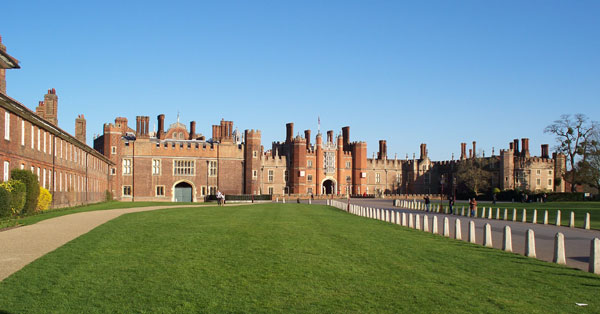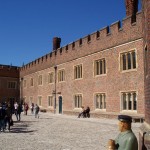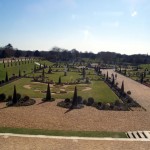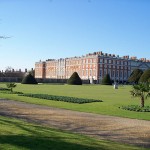 This is one of the Royal Palaces, with the present buildings started by Cardinal Wolsey, extended for Henry VIII, and with a baroque Palace added on for William and Mary, and some further development for the Hanoverians. George II was the last monarch to occupy the Palace, which thereafter was used to provide grace-and favour residences for deserving persons. The residents were typically gentlewomen or widows of men who had provided some distinguished service to the State. The 1000+ rooms available were partitioned up to provide over 50 multi-room apartments.
This is one of the Royal Palaces, with the present buildings started by Cardinal Wolsey, extended for Henry VIII, and with a baroque Palace added on for William and Mary, and some further development for the Hanoverians. George II was the last monarch to occupy the Palace, which thereafter was used to provide grace-and favour residences for deserving persons. The residents were typically gentlewomen or widows of men who had provided some distinguished service to the State. The 1000+ rooms available were partitioned up to provide over 50 multi-room apartments.
In the 20th century the phasing out of the grace-and-favour apartments took place for a number of reasons, the foremost being the impracticality of bringing the often crudely adapted apartments up to 20th century standards of heating, plumbing and convenience. Today, large areas have been reclaimed for public access, and the unseen rooms are used for storage, offices and staff accommodation.
The Palace is big; more of a brick village than a building. The two principal phases of development can be best seen if one stands in the Privy Gardens near the river, where the squarish Baroque block is in front of you and a forest of Tudor chimneys is to your left. The gardens are big too; the best views of the formal gardens can be had by peeking out of windows as you tour the Palace. A canal separates the gardens from the Home Park, but it’s possible to access the Park, where the Long Water stretches off into the far distance, if you have time to tramp around with a map.
Inside, there is a lot to see, and nearly all of it is worth a look. The highlights are Henry VIII’s Great Hall, with its highly carved hammer-beam roof, and the Chapel Royal with its intricate blue and gold ceiling. After that there are the Tudor Kitchens, which have been restored and kitted out to show visitors their original functioning, and the Young Henry VIII exhibition. Then there’s the William III apartments, the Georgian Apartments and other attractions.
Outside, the Privy Garden and Great Fountain Garden should be seen. Then there are the Pond Gardens, Banqueting House and the Great Vine on the river side. On the other side is a large area with the 20th Century Garden, Wilderness, Maze, etc. This latter area is perhaps best taken in as you make your way back to the exit, car park etc at the end of your visit.
Practical Details: There is some car parking (chargeable); an all-day stay will cost several pounds. The Palace is well served by public transport, and if you arrive by rail at Hampton Court station (terminus), finding the nearby Palace is a no-brainer. The HRP website suggests a minimum three-hour visit, but I stayed for about six hours and still did not manage to see everything inside and out.
The only eatery is the Tiltyard Cafe in the grounds. Photography seems to be generally permitted except where they say you can’t, i.e. in the Chapel Royal and the entrances to the few remaining grace-and-favour apartments. Tickets can be pre-booked online, which could save you money and avoid wasting scarce visit time stuck in a lengthy queue in the ticket office.
There is a no-extra-cost tour of the Grace-and-Favour apartments, which is worth catching if you have an hour, as it gets you into one or two spaces not normally open to visitors.



